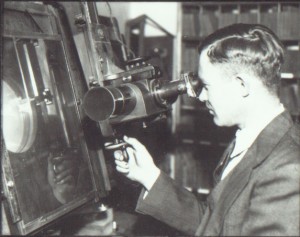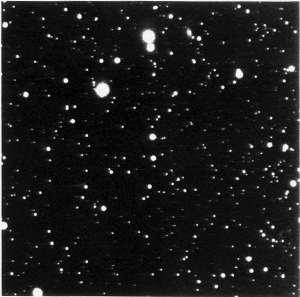While writing the Methods for visualizing dynamic networks post, I remembered a technique that the authors didn’t discuss.
What if only one node in a complex network was different? That is all of the other nodes and edges remained fixed while one node and it edges changed? How easy would that be to visualize?
If that sounds like an odd use case, it’s not. In fact, the discovery of Pluto in the 1930’s was made using a blink comparator exactly for that purpose.
This is Cyrus Tombaugh using a blink comparator which shows the viewer two images, quickly alternating between them. The images are of the same parts of the night sky and anything that has changed with be quickly noticed by the human eye.
Select the star field image to get a larger view and the gif will animate as though seen through a blink comparator. Do you see Pluto? (These are images of the original discovery plates.)
If not, see these http://upload.wikimedia.org/wikipedia/en/c/c6/Pluto_discovery_plates.pngplates with Pluto marked by a large arrow in each one.
This wonderful material on Pluto came from: Beyond the Planets – the discovery of Pluto
All of that was to interest you in reading: GrepNova: A tool for amateur supernova hunting by Frank Dominic.
From the article:
This paper presents GrepNova, a software package which assists amateur supernova hunters by allowing new observations of galaxies to be compared against historical library images in a highly automated fashion. As each new observation is imported, GrepNova automatically identifies a suitable comparison image and rotates it into a common orientation with the new image. The pair can then be blinked on the computer’s display to allow a rapid visual search to be made for stars in outburst. GrepNova has been in use by Tom Boles at his observatory in Coddenham, Suffolk since 2005 August, where it has assisted in the discovery of 50 supernovae up to 2011 October.
That’s right, these folks are searching for supernovas in other galaxies, each of which consists of millions of stars, far denser than most contact networks.
The download information for GrepNova has changed since the article was published: https://in-the-sky.org/software.php.
I don’t have any phone metadata to try the experiment on but with a graph of contacts, the usual contacts will simply be background and new contacts will jump off the screen at you.
A great illustration of why prior searching techniques remain relevant to modern “information busy” visualizations.

